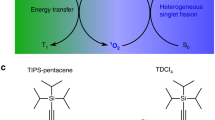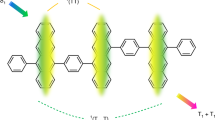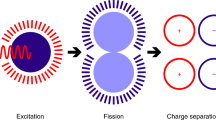Abstract
One strategy to improve solar-cell efficiency is to generate two excited electrons from just one photon through singlet fission, which is the conversion of a singlet (S1) into two triplet (T1) excitons. For efficient singlet fission it is believed that the cumulative energy of the triplet states should be no more than that of S1. However, molecular analogues that satisfy this energetic requirement do not show appreciable singlet fission, whereas crystalline tetracene displays endothermic singlet fission with near-unity quantum yield. Here we probe singlet fission in tetracene by directly following the intermediate multiexciton (ME) state. The ME state is isoenergetic with 2 × T1, but fission is not activated thermally. Rather, an S1 ⇔ ME superposition formed through a quantum-coherent process allows access to the higher-energy ME. We attribute entropic gain in crystalline tetracene as the driving force for the subsequent decay of S1 ⇔ ME into 2 × T1, which leads to a high singlet-fission yield.
This is a preview of subscription content, access via your institution
Access options
Subscribe to this journal
Receive 12 print issues and online access
$259.00 per year
only $21.58 per issue
Buy this article
- Purchase on Springer Link
- Instant access to full article PDF
Prices may be subject to local taxes which are calculated during checkout




Similar content being viewed by others
References
Shockley, W. & Queisser, H. J. Detailed balance limit of efficiency of p–n junction solar cells. J. Appl. Phys. 32, 510–519 (1961).
Hanna, M. C. & Nozik, A. J. Solar conversion efficiency of photovoltaic and photoelectrolysis cells with carrier multiplication absorbers. J. Appl. Phys. 100, 074510 (2006).
Smith, M. B. & Michl, J. Singlet fission. Chem. Rev. 110, 6891–6936 (2010).
Paci, I. et al. Singlet fission for dye-sensitized solar cells: can a suitable sensitizer be found? J. Am. Chem. Soc. 128, 16546–16553 (2006).
Jadhav, P. J., Mohanty, A., Sussman, J., Lee, J. & Baldo, M. A. Singlet exciton fission in nanostructured organic solar cells. Nano Lett. 11, 1495–1498 (2011).
Hong, Z. R. et al. Antenna effects and improved efficiency in multiple heterojunction photovoltaic cells based on pentacene, zinc phthalocyanine, and C60 . J. Appl. Phys. 106, 064511 (2009).
Lee, J., Jadhav, P. & Baldo, M. A. High efficiency organic multilayer photodetectors based on singlet exciton fission. Appl. Phys. Lett. 95, 033301 (2009).
Yoo, S., Domercq, B. & Kippelen, B. Efficient thin-film organic solar cells based on pentacene/C60 heterojunctions. Appl. Phys. Lett. 85, 5427–5429 (2004).
Rao, A. et al. Exciton fission and charge generation via triplet excitons in pentacene/C60 bilayers. J. Am. Chem. Soc. 132, 12698–12703 (2010).
Johnson, J. C., Nozik, A. J. & Michl, J. High triplet yield from singlet fission in a thin film of 1,3-diphenylisobenzofuran. J. Am. Chem. Soc. 132, 16302–16303 (2010).
Wang, C. & Tauber, M. J. High-yield singlet fission in a zeaxanthin aggregate observed by picosecond resonance Raman spectroscopy. J. Am. Chem. Soc. 132, 13988–13991 (2010).
Johnson, R. C. & Merrifield, R. E. Effects of magnetic fields on the mutual annihilation of triplet excitons in anthracene crystals. Phys. Rev. B 1, 896–902 (1970).
Suna, A. Kinematics of exciton–exciton annihilation in molecular crystals. Phys. Rev. B 1, 1716–1739 (1970).
Groff, R. P., Avakian, P. & Merrifield, R. E. Coexistence of exciton fission and fusion in tetracene crystals. Phys. Rev. B 1, 815–817 (1970).
Greyson, E. C., Vura-Weis, J., Michl, J. & Ratner, M. A. Maximizing singlet fission in organic dimers: theoretical investigation of triplet yield in the regime of localized excitation and fast coherent electron transfer. J. Phys. Chem. B 114, 14168–14177 (2010).
Zimmerman, P. M., Zhang, Z. & Musgrave, C. B. Singlet fission in pentacene through multi-exciton quantum states. Nature Chem. 2, 648–652 (2010).
Kuhlman, T. S., Kongsted, J., Mikkelsen, K. V., Møller, K. B. & Sølling, T. I. Interpretation of the ultrafast photoinduced processes in pentacene thin films. J. Am. Chem. Soc. 132, 3431–3439 (2010).
Chan, W-L. et al. Observing the multi-exciton state in singlet fission and ensuing ultrafast multi-electron transfer. Science 334, 1543–1547 (2011).
Burdett, J. J., Müller, A. M., Gosztola, D. & Bardeen, C. J. Excited state dynamics in solid and monomeric tetracene: the roles of superradiance and exciton fission. J. Chem. Phys. 133, 144506 (2010).
Tomkiewicz, Y., Groff, R. P. & Avakian, P. Spectroscopic approach to energetics of excition fission and fusion in tetracene crystals. J. Chem. Phys. 54, 4504–4507 (1971).
Jaeckel, B., Lim, T., Klein, A., Jaegermann, W. & Parkinson, B. A. Deposition of tetracene on GaSe passivated Si(111). Langmuir 23, 4856–4861 (2007).
Thorsmølle, V. K. et al. Morphology effectively controls singlet–triplet exciton relaxation and charge transport in organic semiconductors. Phys. Rev. Lett. 102, 017401 (2009).
Shabaev, A., Efros, Al. L. & Nozik, A. J. Multiexciton generation by a single photon in nanocrystals. Nano Lett. 6, 2856–2863 (2006).
Witzel, W. M., Shabaev, A., Hellberg, C. S., Jacobs, V. L. & Efros, A. L. Quantum simulation of multiple-exciton generation in a nanocrystal by a single photon. Phys. Rev. Lett. 105, 137401 (2010).
Yamagata, H. et al. The nature of singlet exciton in oligoacene molecular crystals. J. Chem. Phys. 134, 204703 (2011).
Wilson, M. W. B. et al. Ultrafast dynamics of exciton fission in polycrystalline pentacene. J. Am. Chem. Soc. 133, 11830–11833 (2011).
Burdett, J. J. & Bardeen, C. J. Quantum beats in crystalline tetracene delayed fluorescence due to triplet pair coherences produced by direct singlet fission. J. Am. Chem. Soc. 134, 8597–8607 (2012).
Nijegorodov, N., Ramachandran, V. & Winkoun, D. P. The dependence of the absorption and fluorescence parameters, the intersystem crossing and internal conversion rate constants on the number of rings in polyacene molecules. Spectrochim. Acta A 53, 1813–1824 (1997).
Zimmerman, P. M., Bell, F., Casanova, D & Head-Gordon, M. Mechanism for singlet fission in pentacene and tetracene: from single exciton to two triplets. J. Am. Chem. Soc. 133, 19944–19952 (2011).
Engel, G. S. et al. Evidence for wavelike energy transfer through quantum coherence in photosynthetic systems. Nature 446, 782–786 (2007).
Panitchayangkoona, G. et al. Long-lived quantum coherence in photosynthetic complexes at physiological temperature. Proc. Natl Acad. Sci. USA 107, 12766–12770 (2010).
Collini, E. et al. Coherently wired light-harvesting in photosynthetic marine algae at ambient temperature. Nature 463, 644–648 (2010).
Kazzaz, A. A. & Zahlan, A. B. Temperature dependence of crystalline tetracene fluorescence. J. Phys. Chem. 48, 1242–1245 (1968).
Swenberg, C. E. & Stacy, W. T. Biomolecular radiationless transitions in crystalline tetracene. Chem. Phys. Lett. 2, 327–3328 (1968).
Geacintov, N., Pope, M. & Vogel, F. Effect of magnetic field on the fluorescence of tetracene crystals: exciton fission. Phys. Rev. Lett. 22, 593–596 (1969).
Burdett, J. J., Gosztola, D. & Bardeen, C. J. The dependence of singlet exciton relaxation on excitation density and temperature in polycrystalline tetracene thin films: kinetic evidence for a dark intermediate state and implications for singlet fission. J. Chem. Phys. 135, 214508 (2011).
Clarke, T. M. & Durrant, J. R. Charge photogeneration in organic solar cells. Chem. Rev. 110, 6736–6767 (2010).
Steinfeld, J. I., Francisco, J. S. & Hase, W. L. Chemical Kinetics and Dynamics 308–401 (Prentice Hall, 1989).
Lim, S-H., Bjorklund, T. G., Spano, F. C. & Bardeen, C. J. Exciton delocalization and superradiance in tetracene thin films and nanoaggregates. Phys. Rev. Lett. 92, 107401 (2004).
Vaubel, G. & Baessler, H. Diffusion of singlet excitons in tetracene crystals. Mol. Cryst. Liq. Cryst. 12, 47–56 (1970).
Robertson, J. M., Sinclair, V. C. & Trother, J. The crystal and molecular structure of tetracene. Acta Cryst. 14, 697–704 (1961).
Müller, A. M., Avlasevich, Y. S., Schoeller, W. W., Müller, K. & Bardeen, C. J. Exciton fission and fusion in bis(tetracene) molecules with covalent linker structures. J. Am. Chem. Soc. 129, 14240–14250 (2007).
Dougherty, D. B. et al. Striped domains at the pentacene:C60 interface. Appl. Phys. Lett. 94, 023103 (2009).
Acknowledgements
This work was supported until 30 June 2011 by the US National Science Foundation under grant DMR-0946346; all experimental measurements were carried out during this time period. The work was continued after 30 June 2011 based on work supported as part of the program ‘Center for Re-Defining Photovoltaic Efficiency Through Molecule Scale Control’, an Energy Frontier Research Center funded by the US Department of Energy, Office of Science, Office of Basic Energy Sciences, under Award Number DE-SC0001085. All theoretical developments were achieved during the period after 30 June 2011. M.L. acknowledges SFB616 and the Leopoldina Fellowship Program LPDS 2009-41 that made his visit to the Zhu group at the University of Texas at Austin possible. We thank R. Wyatt, F. Spano, Al. Efros and A. Shabaev for fruitful discussions.
Author information
Authors and Affiliations
Contributions
W-L.C. and X-Y.Z. conceived and designed the experiments, W-L.C. and M.L. performed the experiments and W-L. C. and X-Y.Z. analysed the data and co-wrote the paper.
Corresponding author
Ethics declarations
Competing interests
The authors declare no competing financial interests.
Supplementary information
Supplementary information
Supplementary information (PDF 1515 kb)
Rights and permissions
About this article
Cite this article
Chan, WL., Ligges, M. & Zhu, XY. The energy barrier in singlet fission can be overcome through coherent coupling and entropic gain. Nature Chem 4, 840–845 (2012). https://doi.org/10.1038/nchem.1436
Received:
Accepted:
Published:
Issue Date:
DOI: https://doi.org/10.1038/nchem.1436
This article is cited by
-
Orbital-resolved observation of singlet fission
Nature (2023)
-
Finding predictive models for singlet fission by machine learning
npj Computational Materials (2022)
-
Open questions on the photophysics of ultrafast singlet fission
Communications Chemistry (2021)
-
Spatial separation of triplet excitons drives endothermic singlet fission
Nature Chemistry (2020)
-
Picosecond timescale tracking of pentacene triplet excitons with chemical sensitivity
Communications Physics (2019)



